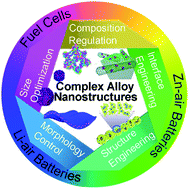Complex alloy nanostructures as advanced catalysts for oxygen electrocatalysis: from materials design to applications
Abstract
The oxygen reduction reaction (ORR) and oxygen evolution reaction (OER) are utilized extensively in energy conversion and storage devices including polymer electrolyte membrane fuel cells (PEMFCs), rechargeable metal–air batteries and water electrolysers. Herein, we review recent breakthroughs in the design of metal alloy-based nanostructures for oxygen electrocatalysis, placing particular emphasis on how alloy structure and complex architecture influence electrochemical performance. Emerging design principles for alloy-based catalysts include composition regulation, size optimization, morphology control, structure engineering, and interface engineering. By employing one or more of these five design principles, a wide range of alloy systems have been successfully developed in recent years that offer superior ORR and OER activity and stability relative to the benchmark Pt/C and IrO2 or RuO2 electrocatalysts traditionally used in these reactions. Further, many of these well-engineered alloy catalysts offer outstanding electrochemical performance as cathode catalysts in PEMFCs or air electrode catalysts in rechargeable metal–air batteries (e.g., Zn–air and Li–air batteries), thus enabling lower cost fabrication of these devices.

- This article is part of the themed collection: Journal of Materials Chemistry A Recent Review Articles


 Please wait while we load your content...
Please wait while we load your content...